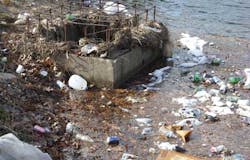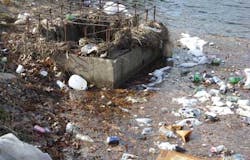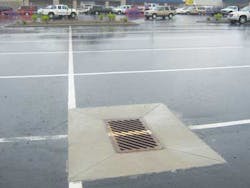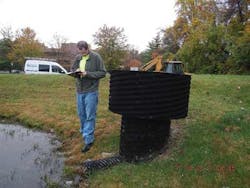Stormwater Utilities Offer Sustainable Funding Mechanism for MS4 Programs
Many municipalities are choosing to establish stormwater utilities for funding and implementation of the Clean Water Act.
By Theodore Scott
Although the Environmental Protection Agency (EPA) passed the Clean Water Act (CWA) in 1972, numerous municipalities and property owners around the country are only now beginning to pay closer attention to this regulation, as its implementation now must be funded.
Many municipalities are choosing to establish stormwater utilities (SU) for funding and implementation. In Maryland, a state law was passed in 2012 that requires the 10 largest municipalities to establish SUs by July 2013. As a result, the property owners will be the direct funding source for CWA implementation.
The CWA, the primary federal law in the United States regulating water pollution, was established with the goal of eliminating toxic substances in the nation's waterways by 1985, and its secondary goal was to ensure surface waters would meet key standards by 1983. A portion of the CWA was the introduction of a permit system, the National Pollutant Discharge Elimination System (NPDES), designed to regulate sources of pollution. These sources can include industrial facilities, municipal governments and other government facilities (such as military bases) and some agricultural facilities.
Sources of pollution are not legally permitted to release pollutants to surface waters without a permit from the National Pollutant Discharge Elimination System (NPDES). There are 46 states authorized by the EPA to issue permits to the discharging facilities.
Permits from the NPDES are issued once every five years. With the current renewal cycle, 20 percent of impervious areas in a particular municipality either need to be removed or must implement a stormwater management system to treat stormwater runoff.
In Maryland, for example, these utilities will be levying fees to owners of properties in order to fund local stormwater infrastructure, allowing it to meet unfunded requirements of the EPA municipal stormwater permits. The fees will be based on the property's impervious area, which includes rooftops, parking lots and other hard surfaces that prohibit water from soaking into the ground.
Why Such Concern with Stormwater?
While there has been a push to enact, regulate and oversee the CWA, any environmentally-conscious issue is inherently political, including this one. Depending on the popularity of a particular issue, elected officials are more or less likely to care about certain issues. Given that environmental issues have become mainstream, lawmakers are beginning to pay more attention to this and other issues impacting our environment.
Polluted stormwater runoff, typically transported through Municipal Separate Storm Sewer Systems (MS4s), is often discharged into local waterways. These waterways are often the same water bodies people use for a variety of purposes. To prevent harmful pollutants from being washed or dumped into an MS4, operators must obtain a NPDES permit and develop a stormwater management program. Further, each regulated MS4 is required to develop and implement a stormwater management program (SWMP) to reduce the contamination of stormwater runoff and prohibit illicit discharges.
What is an MS4?
An MS4 is a conveyance or system of conveyances that is:
- owned by a state, city, town, village, or other public entity that discharges to waters of the U.S.
- designed or used to collect or convey stormwater (including storm drains, pipes, ditches, etc.)
- not a combined sewer
- not part of a Publicly Owned Treatment Works (sewage treatment plant)
Over the years, various phases of the CWA have been enacted to assure continuation of the effort to clean and prevent harmful pollutants from routing into waterways.
These include:
- Phase I, issued in 1990, which requires medium and large cities or certain counties with populations of 100,000 or more to obtain NPDES permit coverage for their stormwater discharges (there are approximately 750 Phase I MS4s)
- Phase II, issued in 1999, which requires regulated small MS4s in urbanized areas, as well as small MS4s outside the urbanized areas that are designated by the permitting authority, to obtain NPDES permit coverage for their stormwater discharges (there are approximately 6,700 Phase II MS4s in the country)
The most common pollutants derived from stormwater runoff include sediment, trash, pathogens, nutrients, and metals. Those managing stormwater programs need to monitor and be aware of the Total Maximum Daily Load (TMDL), which identifies the total amount of runoff that a water body can receive and still meet water quality standards. These TMDLs are determined through an analysis of individual watersheds and whether each meets specific water quality standards for pollutants. The TMDL is implemented through the National Pollutant Discharge Elimination System (NPDES) stormwater permitting system.
After determining the TMDL, a Watershed Implementation Plan (WIP) can then be established. This plan establishes specific actions that need to be taken to meet TMDL requirements.
Frequently, part of the WIP includes outreach to the community to educate and change behavior patterns to eliminate pollution that ends up in waterways. Additionally, part of the plan also includes reforestation and the design and construction of new, modern facilities.
The Elephant in the Room: Funding
As with many government programs, funding is a key concern in attempting to clean up the nation's waterways. Restoration and retrofitting stormwater management facilities in highly urban areas, for example, may cost approximately $250,000 per acre of treatment, depending on the practices being used. This means a single municipality could be looking at upwards of $1 billion just on stormwater management programs. For this reason, the EPA is hearing from many municipalities across the country that they simply cannot fund the enactment of these programs.
As a result, the stormwater field is a breeding ground for innovative approaches. One such innovation is the public-private partnership (PPP) - a contract between a public agency and private sector organization where the skills and assets of each are shared in delivering a service for the benefit of the public. PPPs are increasingly being considered as an implementation mechanism, enabling both the public agency and private entity to share in the risks and rewards potential in delivering the service.
While this is a viable way to implement stormwater management programs, the government has maintained tight controls over the private organizations involved to prevent fraud. Further, this highly regulated environment has inhibited some viable for-profits from getting involved at all.
Regardless of how WIPs will be implemented, sustainable funding mechanisms are mandatory, and stormwater utilities represent a method that's gaining popularity throughout the U.S. Likewise, utility funds can only be used for stormwater-related programs, which help meet MS4 requirements and avoid a raiding of the funds for other uses.
In most cases, both residents and business owners alike are subject to utility fees. In most cases, the size of the fee is proportional to the amount of impervious area on a property: the more area, the greater the fee. While this may result in over $100 per year for larger residential properties in some municipalities, it could be in the tens of thousands - and even hundreds of thousands - of dollars per year for some businesses.
Aspects of these utilities that property owners need to understand are:
- Fee Determination: With thousands of properties being charged, fee determination for various properties is complex and difficult to reduce to very simple terms. Most municipalities are using Geographic Information Systems (GIS) to determine impervious area and related fees. While generally very reliable, these systems can include inaccuracies like approximated property lines from tax map data or miscounted pervious areas surrounded by impervious areas, such as landscaped islands in parking lots.
- Exemptions and Credits: Depending on the municipality, there are quite a few exemptions that may apply. Non-profits and religious organizations may qualify, as well as some NPDES permit holders. In some cases, a storm drain system outfall may affect the fee structure. Most municipalities have credit programs that vary and are somewhat complex.
- Offsite Credits: As many business owners know, it is not always possible to take land out of productive use to construct a stormwater facility in order to qualify for credit. Fortunately, some municipalities are allowing offsite efforts to count toward a credit as long as specific issues, such as long-term maintenance responsibilities, are addressed.
In Conclusion
The issue of funding stormwater management programs continues to remain a priority, and it appears that stormwater utilities are becoming the popular method of payment for programs to help clean the nation's waterways. For land owners, it is essential that they understand the issues, how they can reduce costs and remain involved in ensuring that the charges are accurate.
About the Author: Theodore Scott, PE, CPESC, LEED AP, is Executive Vice President and Founder of Stormwater Maintenance and Consulting, an organization specializing in civil engineering, landscape architecture, environmental analysis, maintenance, and construction as it relates to existing and planned stormwater infrastructure. For more information or to contact the author, please visit www.mdswm.com.



